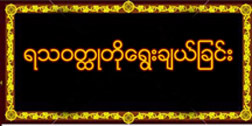Origins of Mahāyāna and the Earliest Mahāyāna Sutras
ME06 21-02-2011 (2:00 to 3:00)
(Class Notes Only)
-------------------
This rendering of The Saddharmapundarika Sutra is an abridgement derived by using selected excerpts from The Lotus Sutra. The Saddharmapundarika sutra is was translated into Chinese in 255 A.D. The earliest part of the text may belong to the first century B.C., while the supplementary chapters date from the third century, A.D.The answer to such questions as why Lord Buddha preached two or three religious systems - Hinayana, Mahayana or in other words conventional truths or ultimate truths - is given in this text by a parable of a burning house. It is clearly stated that Lord Buddha preached one system, not three that is Buddhayana, and the presentation of the three yanas was an example of his skill in the employment of the means. The concept of Triyana, Upayakausalya
(skill in means) and Mahakaruna is thus explained.
In regard to the concept of Lord Buddha as a human being who is both transient and mortal as ourselves according to Sravakayana literature, Lord Buddha is shown as an eternal principal who has long before attained enlightenment and his great compassion is substantiated by repeated rebirths and preaching activities. Again the place has been shifted from For the past ten years the digitization of the world’s Buddhist texts has been vigorously
advancing, and it has come to pass that we have many commonly shared databases.
In several nations of the world. This advancement includes the crafting of tools to assist in projects related to Pali texts, Chinese texts, Tibetan texts and Sanskrit texts, and the development of digital electronic dictionaries. If indeed, it is said that the 20th century was the era when basic Buddhist texts were digitized, then we can consider the start of the 21st century a time when we attempt to satisfy the demands of not only Buddhist scholars, but also the public who want to approach and understand Buddhism. This sutra has 27 chapters, it tried to establish one Yāna, vehicle which has several name, One is Ekayāna, there are Buddhism though generally three forms.
In the Yāna, ‘ā’ is a vowel. The Pali alphabet consists of eight vowels, they are- a, ā, i, ī, u, ū, e and o. The thirty three consonants are; ka, kha, ga, gha, ṅa: ca, cha, ja, jha, ña: ṭa, ṭha, da, dha, na: ṭa, ṭha, da, dha, na: pa, pha ,ba, bha, ma: ya, ra, la, va, sa, ha, ḷa and aṃ. This sa is three types: sa, śa, ṣa.(aḥ, ṛ- Ṛgveda).
[Mahā(big or great) + yāna(vehicle) =Mahanta{Pāli},Mahant{sanscrit}= nibbana] Hina{loba}+yāna is loba one, two, three.
Buddhism are at least three branches; Theravāda, Mahāyāna and Vaijarāyama, this vaijarāyana has future names Tantarayāna and Mahāyāna. In Buddhism which the latter emerged against the former. There are some facts in the four Buddhist Councils. The First Council was held after three months of the Buddha’s death in Rājagaha supported by King Ajatasatthu. There made collect doctrines expounded by the Buddha in his 45- years of journey long and they are recited as Dharma and Vinaya , headed by venerable Mahā Kassapa, venerable Upāli and venerable Ᾱnanda.
The Buddha said to venerable Ᾱnanda “Yo vo Ᾱnanda mamiccayena ‘Yo dhaṁmaṁ passati so mam passati. Yo mam passati so dhaṁmaṁ passati’ ;"Ᾱnanda ! after I’m death ‘One who sees the Dhamma, sees me. One who sees me, sees the Dhamma’." Dhamma has two, they are Sutta and Abhidhamma. In the Sutta Dhamma, the former is not a commentary on a particular canonical text, as its author himself observes, its purpose is to comment on the teaching embodied in the first Four Nīkāya; Diganīkāya, Mijjhimanīkāya, Samyuttanīkāya and Anguttaranīkāya. The Abhidhamma conception of Dhamma is based both on primary and secondary literary sources. As to the former, the relevant texts consulted here are in Pāli, Sanskrit and Sinhala. The Pāli sources are the canonical texts.
The Vinaya Pītaka gives the important rules of discipline concerning four Pārājika and thirteen Sanghādisesa, as well as two Aniyata and thirty Nissaggiya which are minor offences, deals with the remaining sets of rules for the bhikkhus, namely, the ninety two Pācittiya, the four Pātidesaniya, seventy five Sekhiya, seven ways Adhikaranasamatha and the corresponding disciplinary rules for the bhikkhunis. So, Vinaya Pītaka is different of the Bhikkhu vinaya and Bhikkhuni vinaya, that is called Ubatovibinga.
The Second Buddhist Council was held at Vaisāli 1th century after Buddha’s death to solve the ten points held by Vajjian monks. The leaders were venerable Sabbakāmi and venerable Revata, great supported by King Kālasoka, the monks who don’t wanted to change, the Rules were called Theravāda. Wanted to change the Rules called Mahasangika, in competition with former at the Kosambi. Later was divided into seven sects and eleven sects again.
By Ashin Indaka(Kyone Pyaw)























0 comments:
Post a Comment